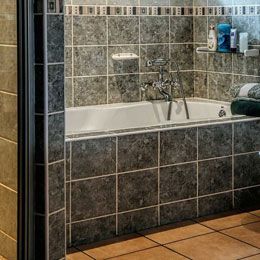
Stone Surface Services Tile & Grout
 Tile and grout are an integral part of the services we offer. Every tile floor, natural stone or otherwise, has grout. That grout can become a real sore point for home and business owners. The trouble with grout is really two fold. First grout is a low point in the floor so it is the most likely place for soil to settle. Second grout is the most porous portion of the floor and high susceptible to discoloration from soil buildup.
Tile and grout are an integral part of the services we offer. Every tile floor, natural stone or otherwise, has grout. That grout can become a real sore point for home and business owners. The trouble with grout is really two fold. First grout is a low point in the floor so it is the most likely place for soil to settle. Second grout is the most porous portion of the floor and high susceptible to discoloration from soil buildup.
There are three types of grout we work on. 1) Sanded 2) Non Sanded 3) Epoxy. Sanded and Non Sanded are the most common that we work on. Sanded grout is characterized by its wider joint and rough texture compared non-sanded grout. Non-sanded grout is smooth and typically used on thin joints and in showers. Epoxy grout is the strongest and most stain resistant of the three but is not commonly used because of its expense.
Tile and Grout Cleaning
There is more than just splashing chemical and water on the floor to cleaning grout. Grout is a natural low point in the floor, as such it is a natural collection point for soils. The number one contributor to the soiling of grout is your mop. If you wet mop a floor all you are doing in moving dirt across the floor and allowing it to collect in grout joints.
Our cleaning process lifts the soils off the floor and from the grout joint. We always pre-treat the soiled area with a degreasing agent that breaks down and emulsifies the soils. The second, and arguably most important, part of our process is the addition of heat. We use a hot water hard surface cleaning system that breaks the emulsified soils from the surface and extracts the solution from the floor.
Tile and Grout Sealing
Regardless of the type of surface it is being applied to there are two general categories of sealer. 1) Penetrating and 2) Film forming. Penetrating sealers are the most common type applied to both grout and natural stone. Film forming sealers are essentially topical waxes. We very rarely apply this type of sealer to any floor because of the general poor result of applying this sealer. It is important to note that penetrating sealers are really moisture repellants. These types of sealers are designed to slow down penetrating agents. For grout our standard operating procedure is to always apply a sealer either clear penetrating sealer or color sealer.
The clear sealer is most commonly used on lightly soiled grout. Heavily soiled grout, even after the soil has been removed, may remain slightly discolored in higher traffic areas. This discoloration is staining left behind by heavy soils.
For floors with heavily soiled and discolored grout we color seal the grout. By applying color seal we can completely change the grout color and ensure complete uniformity in grout appearance across the entire floor.
Tile and Grout Repairs
GROUT REPAIR: It is not uncommon for grout to become damaged over time. Traffic and exposure to corrosive chemicals and water can cause grout to crack and break down. Another common reason for grout damage is slight movement in loose and hollow tiles. As the tiles move the grout cracks and loosens between the tiles. We are able to remove the cracked broken and pitted grout from floors counter tops and showers and install brand new color matched grout. It doesn’t matter the type of grout or area we can repair it. In extreme cases we can regrout entire installations.
TILE REPAIR: From time to time floor and wall tiles can become loose and or crack. For natural stone tiles we can often fill the crack with a color matched resin that, although still visible, appears to be a vein in the stone.
In the case of severely damaged stone and ceramic and porcelain we are often called upon to remove and replace the tile entirely. When this is necessary we pull the tile from the floor, clean the subsurface, apply new motor, reset a replacement tile the regrout with a color matched grout to complete the repair.
